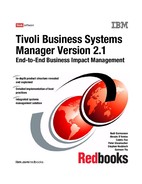134 Tivoli Business Systems Manager Version 2.1: End-to-End Business Impact Management
5.5 Software level and prerequisites
IBM Tivoli Business Systems Manager collects information from multiple
subsystems. This is called an information feed, and it is based on specific levels
of software. You must collect the various data feeds and their software levels to
ensure easier integration into IBM Tivoli Business Systems Manager and identify
discrepancies early.
This section discusses software prerequisites for distributed and mainframe
systems.
5.5.1 Planning for distributed systems
Complete understanding of an enterprise's distributed systems is required to
integrate IBM Tivoli Business Systems Manager into the distributed system
environment.
IBM Tivoli Business Systems Manager supports two basic interfaces for
collecting distributed event data:
? An integrated interface with Tivoli Enterprise Console (TEC) using the event
enablement service. Data sources that route events through TEC include:
– Application Policy Management (APM) instrumentation for heartbeat and
threshold events
– Generic events initiated from rule engine ihstttec
– Tivoli Manager for products
– IBM Tivoli Monitoring modules
? Common listener service. Data sources that route events through the
common listener service include:
– IBM Tivoli Monitoring (ITM)
– IBM Tivoli NetView
– Tivoli Workload Scheduler v8.1
– PATROL
– CA-Unicenter TNG
For IBM Tivoli Business Systems Manager to recognize distributed resources,
they must be mapped to defined resource types within IBM Tivoli Business
Systems Manager.
Chapter 5. Implementation planning 135
The tables and checklists in this section serve as a guide to preparing for
deployment of IBM Tivoli Business Systems Manager for a distributed system
environment.
Tivoli software inventory
From the Tivoli Framework, you can issue wlsinst command to check the
prerequisites for your Tivoli software level.
ITM profile information
To collect information about either your Tivoli Distributed Monitoring or IBM Tivoli
Monitoring profiles and their monitoring contents, use the wlookup command to
obtain the profile name:
wlookup -ar SentryProfile
wlookup -ar Tmw2kProfile
With the profile name, you can collect the profile’s contents.
TEC classes and rules
You must list all BAROC classes and rules to:
? Identify which class you want to monitor
? Decide on is the monitoring mechanism
? Match creation and clearing of event
NetView network structure
You must obtain the primary maps and sub-areas that NetView monitors.
5.5.2 Planning for mainframe systems
The tables and checklists in this section will serve as a guide to prepare for a
deployment of IBM Tivoli Business Systems Manager for mainframe
environment.
The required information is presented in the following checklists:
? “Mainframe and Logical Partition (LPAR) information” on page 136
? “Subsystem information and naming convention” on page 137
? “Subsystems checklist” on page 137

136 Tivoli Business Systems Manager Version 2.1: End-to-End Business Impact Management
Mainframe and Logical Partition (LPAR) information
This information regarding the number and type of physical mainframes and the
LPARs defined on these machines usually can be obtained from the mainframe
System Support team. A sample is shown in Table 5-1.
Table 5-1 List of mainframe information
Operating System id (SMF
id)
SC66 MVS1
Complex ITSO Boulder
Machine SC66Machine RETAIN-Test
LPAR SC66 PRIMARY
Operating System Version and
description
z/OS v1.1
Lab Test system 66
OS/390 v2.10
SysProg Test system
IP address 9.12.14.22 9.99.64.54
SNA information:
• VTAM CP
• Source/390 majornode
• IBM Tivoli Business
Systems Manager SNA
server LU majornode
Not applicable Not applicable
SYSPLEX WTSCPLX1 Not applicable
CICSPLEX SC66PLX Not applicable
Job Entry Subsystem JES2 JES2
Network management NetView for z/OS NetView for OS/390
System Automation Not applicable SA/390 2.1
Job Scheduler TWS 8.1 Not applicable
MVS perfomance monitor RMF RMF
Database subsystem Not applicable DB2 and IMS
Transaction Program
subsystem
CICS Not applicable
Subsystem performance
monitors
CICSPlexSM Not applicable
Security RACF® RACF

Chapter 5. Implementation planning 137
Subsystem information and naming convention
If the traditional bulk discovery process is to be employed, a solid naming
convention for your system will make this process simpler to find and categorize
your enterprise resources.
Table 5-2 Subsystem naming convention
Subsystems checklist
Many of the MVS subsystems consist of further components, which are shown in
the following tables.
IMS
Table 5-3 lists the IMS subsystems checklists for IBM Tivoli Business Systems
Manager implementation.
Table 5-3 IMS subsystems checklist
DB2
Table 5-4 lists the DB2 subsystems for discovery.
Table 5-4 DB2 subsystems checklist
Resource Name pattern
DB2 DB%
IMS IMS??%
CICS ?CICS??
Monitor OMEG%
STC %
Subsystem Version OTMA OS
IMS1A 7.1 Yes MVS1
IMS2A 7.1 Yes MVS1
Subsystem Version Performance
monitor
Data sharing OS Discovery
DB2A 6.1 DB2PM No MVS1 Yes
DSN1 6.1 No No MVS1 No
DSN2 6.1 No No MVS1 No
DSN3 6.1 No No MVS1 No
..................Content has been hidden....................
You can't read the all page of ebook, please click here login for view all page.
